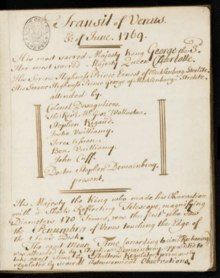Stephen Demainbray
Stephen Charles Triboudet Demainbray (1710 – 20 February 1782) was an English natural scientist and astronomer, who was Superintendent (or King's Astronomer) at the King's Observatory in Richmond, Surrey (now in London) from 1768 to 1782.
Life and work

Demainbray was born in the parish of St Martins, London in 1710.[1] His father, who had come to England from France following the revocation of the Edict of Nantes, died soon afterwards and he was brought up by his uncle, who placed him at Westminster School. There he studied under Dr Desaguliers, who taught him mathematics and natural philosophy. After that he went to the Leiden University.[1]
In 1727 he married; his wife died in 1750.[1]
From 1740 to 1742 he lectured in experimental philosophy in Edinburgh. The 1745 Jacobite Rising brought him to take arms for the government for four years, and he was a volunteer at the Battle of Prestonpans.[1]
In 1746 he resumed his lectures, and worked on the influence of electricity on vegetables. Three years later, he began travelling throughout Britain and Europe, lecturing in Dublin and Paris. In 1753, he was invited to London by the Prince of Wales, later George III, and the Duke of York. On his return to England he married his second wife, Sarah Horne, who was a sister of John Horne Tooke. In 1755 he read a public course of lectures in the concert-room in Panton Street, and later gave private courses to members of the royal family, including the future King George III.[1]
In 1768, he was appointed Superintendent of the King's Observatory (or King's Astronomer) in Richmond, which King George III had commissioned from Sir William Chambers. He arranged for George III to see the Transit of Venus on 3 June 1769. He held that appointment until his death on 20 February 1782.[2] His assistant there was James Stephen Rigaud, who married Demainbray's daughter Mary in Richmond in 1771.
His instruments were combined with the King's collection and given to King's College London and then, in 1927, to the Science Museum.
References
- Lysons, D.: The Environs of London: volume 3: County of Middlesex, entry "Northall (Northolt)", pp. 306–319; 1795. Retrieved 18 February 2016.
- "The Observatory and Obelisks, Kew (Old Deer Park)" (PDF). Local history notes. London Borough of Richmond upon Thames. Retrieved 18 February 2016.